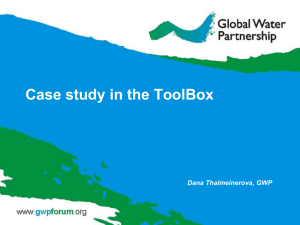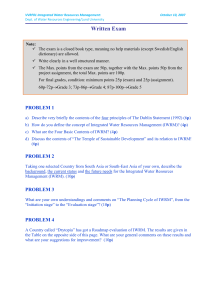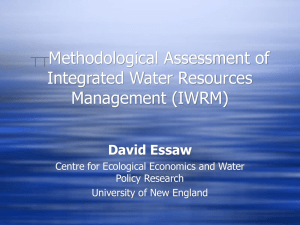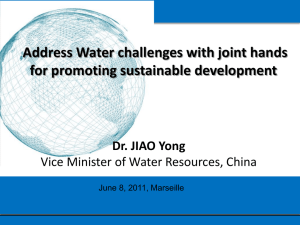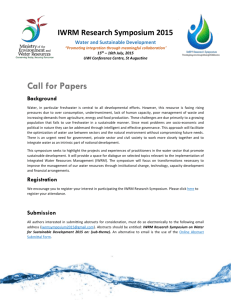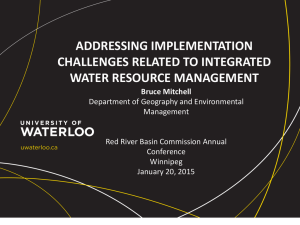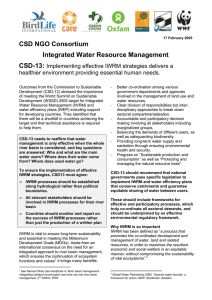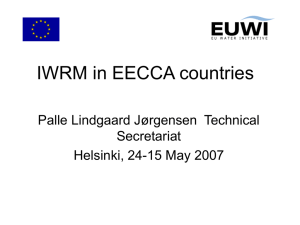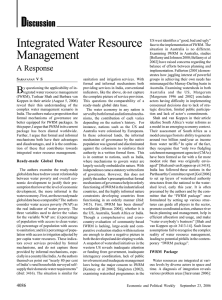integrated water resources management strategy
advertisement
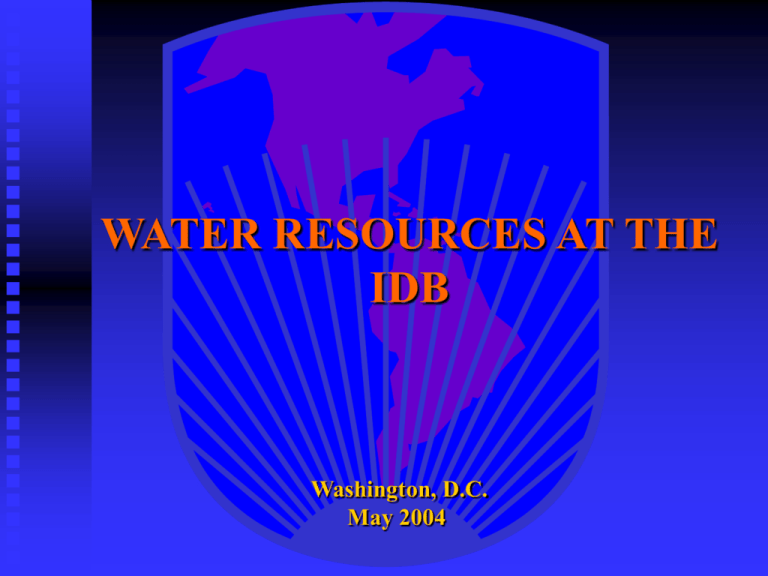
WATER RESOURCES AT THE IDB Washington, D.C. May 2004 STRUCTURE OF PRESENTATION • Overview of LAC • Main Challenges • The IWRM Strategy • Financing the Strategy: The Water Partnership • Pipeline of projects OVERVIEW OF LAC URBANIZATION IN LAC Total LAC = 517 millions % population 100% 80% 389 millions = 75% in urban areas 60% 40% 20% 0% 1960 1965 1970 Latin America 1975 1980 Argentina 1985 Brazil 1990 1995 Guatemala 2000 APPROXIMATELY 116 (50 IN URBAN AREAS) MILLION PEOPLE WITH NO ACCESS TO SANITATION SYSTEMS AND 75 WITHOUT POTABLE WATER (26 IN URBAN AREAS) URBAN FLOODS COST MEXICO US$ 150 MILLION/YR, SEVERE IN CENTRAL AND SOUTH AMERICA (eg CHILE THIS MONTH) 70% OF WATER EXTRACTIONS ARE FOR AGRICULTURE HYDROPOWER GENERATES 64% OF TOTAL ENERGY NAVIGATION VERY IMPORTANT (AMAZON RIVER BASIN, RIO DE LA PLATA BASIN). IN 2000, 18 MILLION TONS OF GOODS WERE TRANPORTED IN THE AMAZON BASIN HYDROPOWER POTENTIAL 3.6 1.0 0.8 70% 72% Europe North America 21% Asia 1.0 6% 1.6 África 33% South America Potential (millions Gwh/yr) Total utilized 70% Percentage utilized MAIN WATER RESOURCES MANAGEMENT PROBLEMS IN LAC WEAK INSTITUTIONS (UNDERFUNDED, POLITICIZED, ILL-ORGANIZED, UNDERSTAFFED) RESULTING IN DETEORIORATED INFRASTRUCTURE AND LOW EFFICIENCIES WEAK REGULATORY FRAMEWORKS PREFERRED OVER INCENTIVE-BASED APPROACHES LACK OF OR OUTDATED LEGAL FRAMEWORKS AND NO ENFORCEMENT HIGH RATES OF URBANIZATION LEADING TO POOR WATER QUALITY WATER RESOURCES MANAGEMENT ACTIVITIES ARE DIFFUSED AND FRAGMENTED WATER HIGHLY CONCENTRATED IN A FEW AREAS MAIN CHALLENGES IN LAC Social Challenges Increase coverage rates Improve health conditions natural hazard risk mitigation Economic Challenges Economic valuation of water resources Water allocation among competing uses integrated approaches to water management Financial Challenges Raise funds for operation and maintenance Financing infrastructure Financing institutional development Environmental Challenges Reduce and control pollution Integrated approaches to water management Ecosystem approach to water management Institutional Challenges Water law reforms Institutional innovation including regulation Stakeholder participation IADBs STRATEGY ON INTEGRATED WATER RESOURCES MANAGEMENT THE GOALS SUPPORT THE IMPLEMENTATION IN LAC OF: PRINCIPLES OF DUBLIN AGENDA 21 THE SAN JOSE DECLARATION BOLIVIA SUMMIT DEVELOPMENT ON SUSTAINABLE SPECIFIC OBJECTIVES CHANGE IN PARADIGM: FROM DEVELOPMENT TO MANAGEMENT FROM SECTORAL TO INTEGRATED APPROACHES IN WATER RESOURCES LEADING TO: MORE EFFICIENT WAYS TO ALLOCATE AND CONSERVE WATER AND TO SOLVE CONFLICTS AMONG COMPETING USES; ACCOUNT FOR THE SOCIAL, ECONOMIC AND ENVIRONMENTAL VALUE OF WATER; AND INCREASE PARTICIPATION OF THE PRIVATE SECTOR AND COMMUNITIES GUIDING PRINCIPLES PROMOTING COMPREHENSIVE NATIONAL WATER RESOURCE MANAGEMENT POLICIES AND STRATEGIES FOCUS ON INSTITUTIONAL INNOVATION AND CAPACITY BUILDING ATTENTION TO BOTH SHORT- AND LONG-TERM EFFORTS FOR BANK ACTION CONFORMING TO BANK’S AND COUNTRIES OBJECTIVES AND TO INTERNATIONALLY ACCEPTED PRINCIPLES INCENTIVES FOR COUNTRY INVOLVEMENT AND FOR INTERNAL BANK COORDINATION; AND COOPERATION AND COORDINATION AMONG INTERNATIONAL FINANCIAL ORGANIZATIONS SITUATIONS TO ENCOURAGE INTEGRATED WATER RESOURCES MANAGEMENT STAKEHOLDER EMPOWERMENT AND PARTICIPATION PRIVATE SECTOR PARTICIPATION ENTITY TO COORDINATE “TOP-DOWN” AND “BOTTOM-UP” APPROACHES MARKET OR OTHER INCENTIVE-ORIENTED MECHANISMS TO ALLOCATE THE RESOURCE ENTITY TO COORDINATE, FACILITATE, AND REGULATE THE PROCESS OF WATER ALLOCATION PLACED OUTSIDE AND ABOVE OF ANY SPECIFIC WATER-USE-SUB-SECTOR STRATEGIC INSTRUMENTS COST RECOVERY PRIVATE SECTOR PARTICIPATION CAPACITY BUILDING STAKEHOLDER PARTICIPATION DECENTRALIZATION TRADABLE WATER RIGHTS RIVER BASIN COUNCILS LEVELS OF ACTION FOR THE BANK CONSTITUTIONAL LEVEL: Establishing laws and policiesa national strategy for integrated water resources management ORGANIZATIONAL LEVEL: River basin management- allocating water flows, assimilative capacity, ecosystem maintenance, capability, potential energy OPERATIONAL LEVEL: Water uses and users-using water resources, subject to operational rules, to meet demands and needs FINANCING THE STRATEGY BANK INSTRUMENTS IDB MIF PRI IIC •COUNTRY DIALOGUE •COUNTRY AND REGIONAL TECHNICAL ASSISTANCE GRANTS •TRUST FUNDS •SECTOR AND HYBRID LOANS •PROJECT SPECIFIC LOANS •SMALL PROJECT LOANS •COFINANCING •COUNTRY AND REGIONAL TECHNICAL ASSISTANCE GRANTS •FOR MICROENTERPRISE AND SMALL ENTERPRISE •EQUITY FUNDS/INVESTMENTS •SMALL BUSINESS VENTURE CAPITAL FUNDS •PRIVATE SECTOR LOANS •GUARANTEES •SUBORDINATED LOANS •PRIVATE SECTOR LOANS TO SMALL AND MEDIUM •ENTERPRISE •EQUITY FUNDS/INVESTMENTS •COFINANCING The IDB-Netherlands - Water Partnership Program INWAP INWAP´S OBJECTIVE: The general objective of INWAP is to support the implementation of internationally recognized principles of integrated water resources management (IWRM) in Latin America and the Caribbean. This objective will be achieved through joint efforts: internally to improve and strengthen the Bank’s operational capacity in the area of IWRM, and externally to improve such capacity in the Bank’s borrowing member countries. INWAP 2004 Work Plan centers around two sets of strategic priorities: The ones stated on the Bank´s Institutional Strategy The ones stated on the Bank´s Integrated Water Resources Management Strategy Priorities stated under the Bank´s Institutional Strategy: The Bank´s two overarching objective are: a) sustainable economic growth, and b) poverty reduction and the promotion of social equity, implemented through four priority actions areas: social development, modernization of the state, competitiveness, and regional integration. Environment is a cross-cutting theme. Priorities stated under the the Bank´s Integrated Water Resources Management Strategy : The goal of the strategy is:…¨to support water resources conservation through a process of change regarding water resources issues; namely, a shift from development to management and from a sectoral to an integrated approach¨. The strategy aims to mainstream critical aspects of IWRM related to each country’s water sector in general in the Bank’s water-related operations. Strategic Lines of Action for the 2004 Work Plan: Based on the main objectives of the Bank and the principles of the IWRM Strategy, new eligible activities will place emphasis on: Poverty Reduction and the Promotion of Social Equity Water Governance Poverty Reduction and the Promotion of Social Equity Areas of concentration are: a) support compliance with the Millennium Development Goals (MDGs) in potable water and sanitation and b) provide the methodological tools to assess the impact of waterrelated activities on the poor. Water Governance Areas of concentration are: a) support the formulation of IWRM strategies and plans as set in the Implementation Plan of the World Sustainable Summit and b) strengthen the institutional, legal, and policy frameworks of the Bank's borrowing member countries. Strategic Lines of Action for the 2004 Work Plan: Based on the main objectives of the Bank and the principles of the IWRM Strategy, new eligible activities will place emphasis on: Poverty Reduction and the Promotion of Social Equity Water Governance INWAP´s Strategic Activities for 2004 INWAP´s Strategic Activities for 2004 IDB´s IWRM Strategy Objectives Poverty Reduction MDG´s in water and sanitation Water and poverty Facility for Small Scale Providers in Water Empirically Linking Water and Poverty Wate Governance IWRM strategies and plans Institutional, legal and policy frameworks Water Resources Plan for Brazil Water Policy for Bolivia Awareness and Training Strategy on IWRM Plans National Tariff Framework for Peru Technical Seminar on WQM Congress on Public Policies for WRM Course on IWRM for Central America Capacity Building for Legislators Pipeline of IDB Loans For 2004-2005 there are approx. USD 2.9 billion in the pipeline USD 1 billion in hydropower (Tocoma in VE, Porce III in CO, two small PRI projects in BR and PN) USD 250 million in irrigation (BR, ME and JA) USD 1.5 billion in potable water and sanitation (large loans in ME and BR and smaller loans in variety of countries) USD 40 million in watershed management (CR, PN and VE)
